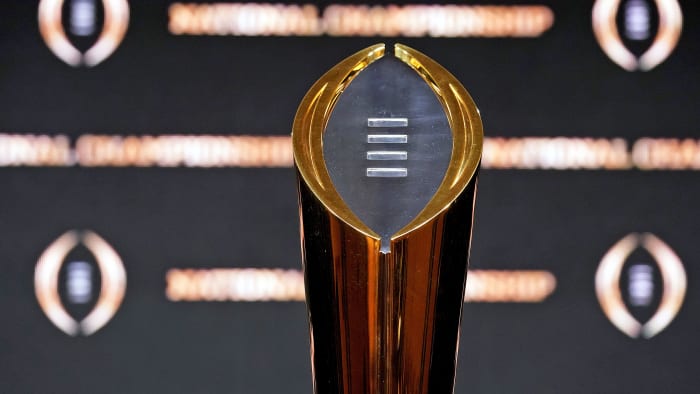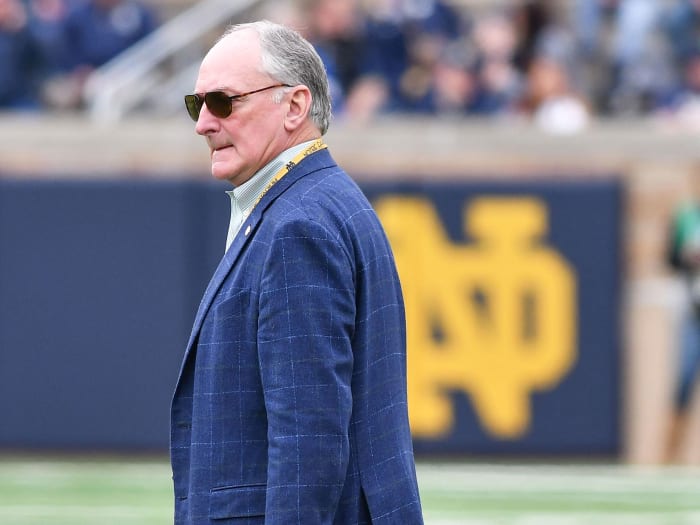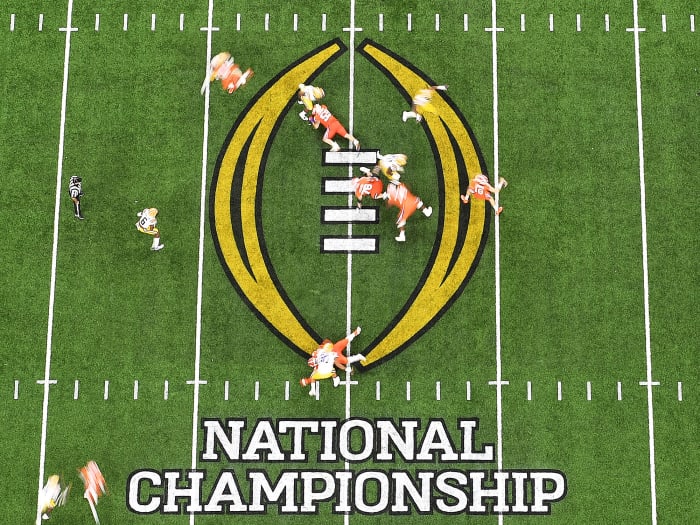Bob Bowlsby cannot recall what he scribbled on the outside of the envelope—A bracket? A scenario? A ranking?—but he believes it to be something of significance.
Otherwise, why would he keep it?
The envelope is somewhere, likely buried in a filing cabinet or tucked into a box, alongside other hand-scribbled notes that Bowlsby took during his two years of meetings as a member of the College Football Playoff working group—the one that explored and eventually proposed an expansion of the four-team playoff to 12.
Bowlsby, the Big 12 commissioner, is preserving these precious, historic documents to one day, years from now, unearth them in a dramatic way, as evidence of a process that will likely result in a sea change in college athletics.
For now, Bowlsby snickers, no one will get their hands on them.
“I know I have something on the back of an envelope somewhere,” he mutters.
If Bowlsby did reveal his notes, they’d tell quite a tale: how four college athletics executives spent two years, in secret, covertly meeting at airport hotels while using masking tape to cover conference room walls with drawn-up brackets, to create an expanded playoff model that they publicly released last week.
If Bowlsby’s notes could talk, they’d tell you that the working group of three commissioners—Bowlsby, Greg Sankey (SEC) and Craig Thompson (Mountain West)—and one athletic director, Jack Swarbrick (Notre Dame), examined nearly 100 playoff models, one of which even included a 24-team bracket.
They’d tell you that the four men seriously toyed with leaving the format at four teams but with an adjustment: moving selection date to early January, after bowls were completed. In fact, the group discussed brackets of seven and nine teams that included play-in games.
At least one of the men will tell you that their big secret was nearly spoiled this spring by an inquisitive fan in the Dallas/Fort Worth International Airport and that their decision to announce the proposal as they did—first with a vague release in April and then a more detailed announcement in June—was at the advice of Ari Fleischer, the former press secretary to George W. Bush.
Finally, Bowlsby’s notes would tell you that the group had mostly reached consensus on the number of participants in their playoff proposal (12) even before the pandemic arrived, some 15 months ahead of last week’s unveiling.
They kept it quiet all this time.
“That’s the greatest triumph of this deal without question,” says Swarbrick. “People didn’t even know what was going on. We all swore ourselves to secrecy.”
***

John David Mercer/USA TODAY Sports
The first chapter of this story begins in, of all places, San Jose, Calif., near the site of the 2018 national title game between Alabama and Clemson.
Within a lavish, downtown hotel, Mark Keenum, the Mississippi State president and the chair of the CFP’s highest governance body, the Board of Managers, approached CFP executive director Bill Hancock in January 2019 with a directive: examine the playoff.
Does it need expanding? If so, how many teams?
From that request, the four-member playoff working group was born, assembled based on diversity and seniority from the 11-person CFP Management Committee, made up of the 10 FBS conference commissioners and Swarbrick. The working group included two influential, veteran Power 5 commissioners (Sankey and Bowlsby), the longest-tenured Group of 5 commissioner (Thompson) and the middle man, Swarbrick, who, as a former attorney, became the face of the group—the lead author, so to speak, of this undertaking.
None of the men seem to remember exactly how they were told of their selection to this playoff expansion committee. In fact, Bowlsby, only half-joking, says he left the room to tinkle and returned to learn the news.
“I will wet my pants next time,” he chuckles.
Two years of work, hundreds of hours of meetings, reams of notes, rolls of masking tape and dozens of catered meals later, the group delivered a virtual presentation to their other seven colleagues last Thursday. Swarbrick flipped through 51 slides over 57 minutes. They took no questions. There was no discussion. This was only a precursor to their in-person meetings this Thursday and Friday in Chicago.
Swarbrick will give a similar presentation next week in Dallas, when both the CFP Management Committee and the CFP Board of Managers—11 school presidents—meet jointly for their annual summit. The Board of Managers is expected to rubber stamp a 12-team proposal that grants guaranteed spots to the six highest-ranked conference champions while allotting at-large bids to the next six highest-ranked teams.
“Ultimately next Tuesday, the Board of Managers will say, ‘Carry on and continue!’ ” says Thompson. “Or they’ll say, ‘Good plan but we’d rather just stay at four.’ I don’t suspect that’s going to happen.”
After all, the presidents were the ones who really wanted this to begin with.
In fact, the working group was under internal pressure from the presidents—something overshadowed in this entire endeavor. During the two years of work, Swarbrick was responsible for updating the presidents two different times, both of which featured no real updates at all.
“The second time I gave that update, they made it very clear that they didn’t want a repeat the third time,” Swarbrick says.
***

Notre Dame athletic director Jack Swarbrick was part of the four-person working group.
Matt Cashore/USA TODAY Sports
For many Americans, March 2020 will forever be marked by the beginning of the COVID-19 pandemic. While that’s also true for the four college executives on the playoff working group, the month also represents a breakthrough in what was then a year’s worth of exploring playoff expansion models.
During the first week of March 2020, about two weeks before life in America paused, the four men met in the Grand Hyatt at the Dallas/Fort Worth airport and reached a consensus.
They would recommend a 12-team playoff.
And then, they did not meet again in person for 13 months.
“You lost so much when you went virtual,” Swarbrick says. “It really slowed us up.”
Before that March 2020 meeting, the four men and two others—Hancock and Dave Marmion, the CFP chief financial officer—met at least a half-dozen times, usually in small hotel conference rooms, equipped with two easels of paper, masking tape and markers. By the end of the meeting, the walls would be completely covered in models similar to those that had social media buzzing last week.
How would this model and that model have played out in years past?
“They would make notes on paper and stick them to the wall,” says Hancock. “It was very structured and orderly. One thing that was helpful was putting potential brackets on the wall. We all love brackets.”
Each person took individual notes, and Hancock’s staff kept the story-boarding brackets and models to keep some consistency from one meeting to the next. Some of the meetings would last an afternoon. Others would stretch over two days.
“Every so often somebody would say, ‘Somebody keep these!’ ” Thompson recalls. “There is copious note-taking. It was a very legitimate process. When we would think something was quasi-solved, one of the members would say, ‘Wait a minute! If we did this, it would mean that!’ ”
In the early days, they established one very important goal: grant access, in some way, to the Group of 5. From there, things got easier. They spent the majority of their time modeling five potential brackets: a seven, eight, nine, 10 and 12-team playoff, each with a half-dozen or more variations. Before reaching that point, though, Bowlsby says the committee at least briefly studied a 24-team bracket.
“We never really gave serious consideration to 24, but it was on the board,” he says. “We knew it worked for FCS.”
They attempted to poke holes in each of their models. For instance, 24 and 16-team models would be too many extra games. An eight-team model—one of the heavy favorites early on—posed other problems. Guaranteeing six conference champions a spot in an eight-team model meant that only two at-large teams got in.
“Going from four at-larges like we have now to two at-larges just didn’t make a lot of sense,” Hancock says.
Sankey says he was against such an eight-team model, describing the decreasing number of at-large selections as “counterintuitive” to expansion.
While he supported an eight team at-large model—often described as a “best eight”—he acknowledged the expectation from others to have guaranteed access.
They seriously weighed keeping the model at four teams, the commissioners say, but with a twist. The selection committee wouldn’t pick the participants until the major bowls were played. The bowls would be, in many ways, de facto quarterfinals. In the end, the men wanted to grant more access. It’s why, in a somewhat stunning turn of events, they settled on 12.
Even Swarbrick acknowledges that he originally entered the negotiations thinking 12 was too many.
“No one saw this model coming when we started,” he says. “Once you got to where you thought it was appropriate to have six, the analysis and gap analysis and who was left out, it started to move you to 12.”
In modeling of the last seven years, the 12-team proposal would have only included four teams that finished outside the committee’s final top 12 rankings, the worst of which was ranked 20th. All four were a Group of 5 conference champion.
MORE: How Previous Playoffs Would’ve Looked With 12 Teams
Automatic qualifiers were a nonstarter, group members say. The notion of AQs had become a “dirty word” that commissioners wanted to avoid, Swarbrick says, hence their decision to guarantee spots not to Power 5 conference champions but to the six highest-ranked conference champions.
“What if Trevor Lawrence got hurt in the first series of the ACC championship game and Pitt beat Clemson?” asks Swarbrick. “Those specific examples led us to that conclusion.”
In the end, no one compromised as much as Swarbrick. As an independent, Notre Dame will not have the opportunity to ever land a first-round bye. It’s a tradeoff, he says, for not having to play a league championship game.
Sankey, one of the most outspoken supporters of the four-team model, compromised as well.
“On the national stage, we were the outlier in resisting any notion of playoff expansion,” the SEC commissioner says. “We could be the contrarian or have the responsibility to shape the process.”
***

James Lang/USA TODAY Sports
After a 13-month break from in-person meetings, the CFP working group gathered in the Dallas area this past April for what they describe as the consequential and final meeting of two years worth of discussions.
Inside the Four Seasons Resort in Irving, Texas, the letters C-F-P were absent. They weren’t featured on the hotel’s schedule of meetings. They weren’t on the door to the conference meeting room where four of college football’s most important people discussed playoff expansion.
They were, purposely, nowhere to be found.
“I recall the first meeting back together in person this spring, we were especially careful,” Swarbrick recalls.
Up to that point, not only had no information leaked publicly about details of the meetings—but no news had even leaked that there was a working group exploring a playoff change.
The jig was nearly up this past spring, when a Notre Dame fan spotted Swarbrick in the Dallas/Fort Worth airport and questioned his travel plans.
“What are you doing here?” the fan asked.
After a few awkward seconds, Swarbrick blurted out, “Oh, just some industry meeting!”
Even their fellow commissioners knew very little about the group’s progress and meeting content. They were aware only that a group was examining the future of the playoff. Swarbrick occasionally updated them, keeping things exceptionally vague.
Working group members feared that, if news escaped, outside scrutiny would have ruined the entire endeavor. For two years, no more than eight people knew the details of the group’s discussions.
Toward the end of the process, commissioners brought into the fold Fleischer, a longtime political aid and media consultant who has been consulting with college football’s postseason system since its days as the BCS. Fleischer advised the public rollout of the new playoff model, the first of which was an April 23 statement from Hancock revealing only vague details of the working group’s progress.
The next step was presenting the proposal in secret to the full CFP Management Committee this week in Chicago. But the group reversed course. Commissioners decided to reveal their model to colleagues last week in a virtual presentation that preceded a detailed public statement and a media conference call Thursday evening with Hancocks and the four members of the working group.
It was an about-face that caught many off guard. But it wasn’t without reason.
“You cannot just walk into Chicago and lay a 51-page document on commissioners and say ‘Here’s our plan—got any questions?’ ” Thompson says.
Many commissioners actually expected the presentation and announcement to come earlier last week, on Monday or Tuesday. But a scheduled Senate hearing on Wednesday over athlete compensation triggered the delay to Thursday.
The delayed announcement caused some scheduling snafus for the working group. In fact, during the group’s media call, one commissioner found himself calling into the teleconference while hunkered down in a machine shed on a horse ranch in the middle of Colorado, as tractors cleared land in preparation for his daughter’s wedding last Saturday.
“It was 97 degrees in the shed,” laughs Thompson.
Sankey was driving to Roanoke, Ind., for a family dinner that preceded his own daughter’s wedding last weekend, and Bowlsby was in Utah at—you guessed it—a family wedding.
That’s why Bowlsby couldn’t immediately produce his notes from the two years of meetings. Nor could he exactly recall what he scribbled on that envelope.
Either way, they’re somewhere, in a box or cabinet, below a desk or in a drawer, ready to be revealed one day as evidence of one of the more successful undertakings in college sports history, in which the main feature was ripping pieces of paper off an easel and sticking them to a hotel conference room wall.
In reality, there’s much more to it, of course.
“There will probably be some unintended consequences. I don’t know what they will be but somebody out there probably has a better idea or has good reasons,” Bowlsby says. “We got together, trusted one another and left our hat at the door. It’s hard to be a commissioner responsible for the best interests of your members and also doing what is responsibly nonpartisan in terms of shaping what’s best for college football going forward.
“That may be the part that I’m most proud of.”
More Playoff Expansion Coverage:
• Exploring the Weaknesses of a 12-Team Playoff
• College Football Looks to Be Getting Expansion Right
• College Football Will Reap Benefits of Expanded Playoff
